Day Seven
Alton, IL, Scenic River Town
CmCBI[gA~VVbsΝΘΜ`¬
[Note] If this page is too small to be readable, please enlarge it to 120-125%. Thank you.
After enjoying the Mississippi River cruise in Hannibal, we spent all afternoon driving back to St. Louis. We drove on National Highway 61 South, from Hannibal to
Wentzville. In Wentzville we switched to Interstate Highway 70 East. About 30 minutes' drive took us back to the Lambert-St. Louis International Airport area. We checked in Comfort Inn
St. Louis Airport (which closed a couple of years later and has then reopened as RL Hotel St.Louis Airport). This hotel had already had some bad reputations, but we didn't have
any particular trouble while we stayed, except that a drankard persistently begged me for a bus fare that he said needed to go back home at a fast food restaurant just in front of the hotel.
I went to the restaurant in hunger after a long drive, but the other people felt too exhausted, they straight got to sleep without having any food.
Next day we first visited Alton, Illinois, which is an old river town that is located north of St. Louis, just across the Mississippi River. Alton has a very unique
geographical feature: three rivers meet at this town: the Mississippi, the Missouri, and the Illinois rivers.
Alton is the birth town for several celebrities, one of whom is Miles Davis. We love jazz music, so the first thing we did in this town is to visit his birth house. We
found it on a small road several blocks away from the Mississippi River, going north. It was a small one-story house and looked so private. We didn't want to disturb the owner. We just drove around it
slowly and left quietly.
We then headed to the Lincoln-Douglas Square on E. Broadway Street. The Lincoln-Douglas Square is a small park that is famous for the fact that Albraham Lincoln
debated with Stephen Douglas for the U.S. Senate seat in 1858.
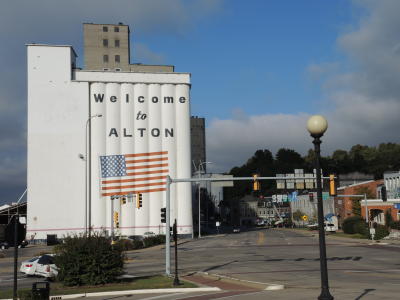
Threre are lots of Abraham Lincoln Historic Sites in the State of Illinois. Alton has some, too. This photo shows the intersection at the west end of
East Broadway Street. The old City Hall of Alton used to stand in the front corner of it. Here the last debate between Abe Lincoln and Steven Douglas was held for the Illinois
U.S. Senate seat in 1858.
The big white building wall (which is actually a combination of seven very tall silos) with a huge American flag painted on it is a part of the Ardent Mills Alton Facility. This is a factory
that produces various blends of flour that eventually turn to bread, buns, pizza, cookies, crackers, and many more!
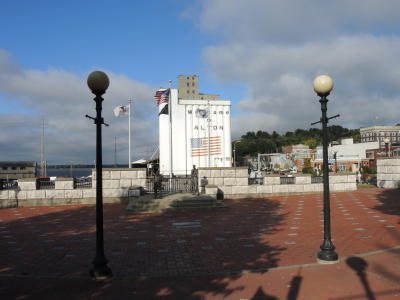
This photo shows the entire view of the Lincoln-Douglas Square. The old City Hall of Alton used to stand here. You probably see two statues standing in the far side of the photo
with the big American flag in their back. The right-side stature represents Abe Lincoln whereas the left one represents Stephen Douglas. The Mississippi River is seen in the left end
of the photo, around the middle point. Single-click for enlargement of the photo.
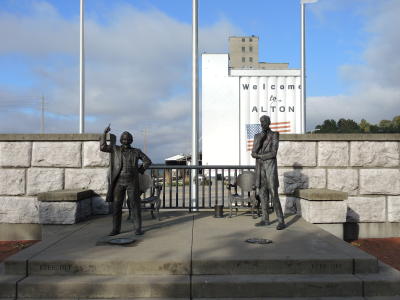
The same two statues zoomed in. In this seventh debate for the Illinois U.S. Senate seat, Lincoln spoke that "by excluding the Negro from the Declaration of Independence
Douglas...[takes] away from the Negro the right of striving to be a man." (Source: the National Park Service web site)
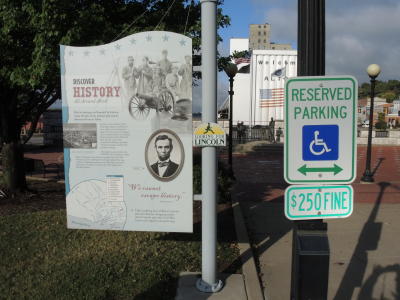
This description board stands at the parking lot by the Lincoln-Douglas Square. It explains an important role that Alton played at the time of Civil War. Alton was the biggest
river town in the Southern Illinois in the mid 19th century America, so all kinds of people were bustling here. The board tells that Alton was the very town to have the first
casualty of Civil War because Elijah Lovejoy, an active abolishonist in the town, was assassinated at the dawn of the war.
The board also introduces to us one important Lincoln quote: "We cannot escape history." This sentence was written in a message that he sent to the Congress on December 1, 1862. What this
sentence means is that any one of us cannot escape the final judgment made by history itself. No matter what deed, good or bad, we may take, we cannot evade the final evaluation, either
honorable or shameful, that history will eventually make on us. By this, Lincoln asked all Congerss members to follow one important American creed that the Declaration of Independence
hoists high up in the sky, which is the freedom for all.
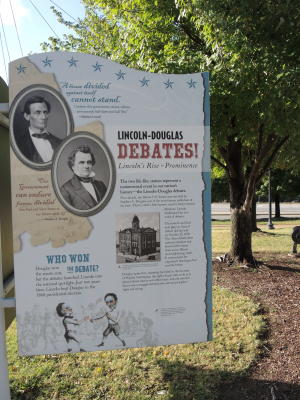
This description board details the final Lincoln-Douglas debate on October 15, 1858. Stephen Douglas took the podium first. He asserted that "Our government can stand
forever, divided into Free and Slave States as our Fathers made it." Lincoln talked back to him, speaking: "A house divided against itself cannot stand. I believe this
government cannot stand forever, permanently half slave and half free."
The number of people who came to hear this debate was about 6,000, which is a huge number when we think of the lack of any convenient transportation at that time. Those people watched
the two politicians' debate, standing by the east wall of the old city hall building, which burned down by fire in 1924.
The stage on which the two men debated is probably at the same place as the two life-like statues for the both men now stand.
Day Seven continues to the next page.
΅ϊΪΝΜy[WΙ±«ά·B
|













